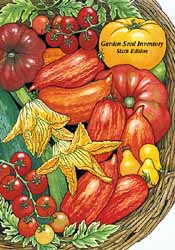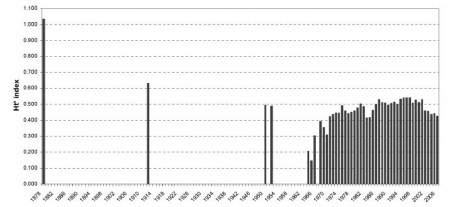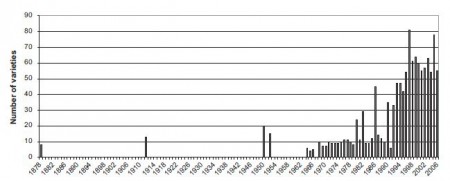Jeremy’s recent piece of detective work with the current edition of the Garden Seed Inventory, coming hot on the heels of my own piece on how diversity in French wheat has changed during the past hundred years, reminded me of a post of ours a couple of years back that could now bear revisiting. It was about a paper that had re-analyzed historical data from vegetable seed catalogues old and new to suggest that maybe the metanarrative of genetic erosion had been overdone:
If the meaning of diversity is linked to the survival of ancient varieties, then the lessons of the twentieth century are grim. If it refers instead to the multiplicity of present choices available to breeders, then the story is more hopeful. Perhaps the most accurate measure of diversity would be found in a comparative DNA analysis of equal random samples of old and new varieties, work that remains to be done.
The alleged grounds for hopefulness are that Drs Heald and Chapman, the authors, found 7100 varieties in 2004 catalogues, “only 2 percent fewer than one hundred years earlier. By this measure, consumers of seeds have seen almost no loss of overall varietal diversity”. Well of course that French wheat work is indeed as close as we’re likely to get to the “DNA analysis of equal random samples of old and new varieties.” And, alas, it shows what Jeremy said at the time was all too possible, and that is that genetic diversity can go down even when varietal diversity, meaning the number of cultivars of a crop, goes up. Grim after all.
Trawling seed catalogues is good fun, and can give you some clues as to what genetic erosion may be happening, but in the end it is diversity at the genetic level that really counts, let’s remember that. The geneticist JBS Haldane famously said that he would lay down his life for two of his brothers or eight of his cousins. That’s just a striking way of saying that you’re more closely related to your brother than to your cousin. The corollary of that is that there’s more genetic diversity in a group of cousins than in a group featuring the same, or indeed even a greater, number of brothers.
We still don’t know if those 7100 varieties in the 2004 catalogues are more brothers or cousins, but, if French wheat is anything to go by, the former is more likely. 1 You may think you have a “multiplicity of present choices”, but if in fact you only have brothers to choose from, you could be forgiven for the temptation to trade a whole bunch of them for a cousin or two.
Assuming you can get hold of them, that is.
 Thanks to the very good offices of our friends at
Thanks to the very good offices of our friends at 

